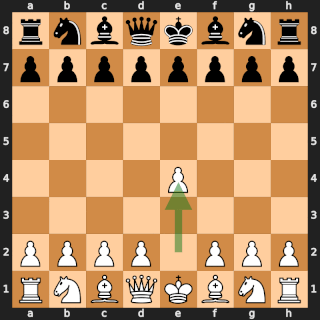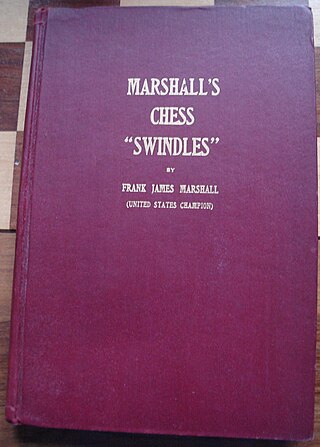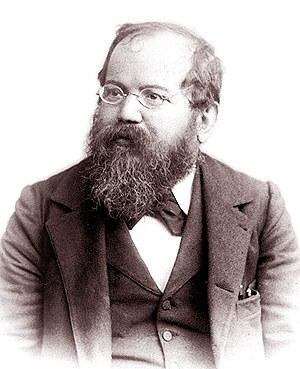In the game of chess, perpetual check is a situation in which one player can force a draw by an unending series of checks. This typically arises when the player who is checking cannot deliver checkmate, and failing to continue the series of checks gives the opponent at least a chance to win. A draw by perpetual check is no longer one of the rules of chess; however, such a situation will eventually allow a draw claim by either threefold repetition or the fifty-move rule. Players usually agree to a draw long before that, however.
Stalemate is a situation in chess where the player whose turn it is to move is not in check and has no legal move. Stalemate results in a draw. During the endgame, stalemate is a resource that can enable the player with the inferior position to draw the game rather than lose. In more complex positions, stalemate is much rarer, usually taking the form of a swindle that succeeds only if the superior side is inattentive. Stalemate is also a common theme in endgame studies and other chess problems.

The Immortal Game was a game of chess, played in 1851 by Adolf Anderssen and Lionel Kieseritzky. It was played while the London 1851 chess tournament was in progress, an event in which both players participated. However, the Immortal Game was itself a casual game, not played as part of the tournament. Anderssen won the game by allowing a double rook sacrifice, a major loss of material, while also developing a mating attack with his remaining minor pieces. Despite losing the game, Kieseritzky was impressed with Anderssen's performance. Shortly after it was played, Kieseritzky published the game in La Régence, a French chess journal which he helped to edit. In 1855, Ernst Falkbeer published an analysis of the game, describing it for the first time with its namesake "immortal".

The Opera Game was an 1858 chess game, played at an opera house in Paris. The American master Paul Morphy played against two strong amateurs: the German noble Karl II, Duke of Brunswick, and the French aristocrat Comte Isouard de Vauvenargues. It was played as a consultation game, with Duke Karl and Count Isouard jointly deciding each move for the black pieces, while Morphy controlled the white pieces by himself. The game was played in a box while an opera was performed on stage. Morphy quickly checkmated his opponents following rapid development of material, involving a queen sacrifice.
The zwischenzug is a chess tactic in which a player, instead of playing the expected move, first interposes another move posing an immediate threat that the opponent must answer, and only then plays the expected move. It is a move that has a high degree of "initiative". Ideally, the zwischenzug changes the situation to the player's advantage, such as by gaining material or avoiding what would otherwise be a strong continuation for the opponent.

The Hastings 1895 chess tournament was a round-robin tournament of chess conducted at the Brassey Institute in Hastings, England from 5 August to 2 September 1895.
In chess and other related games, a double check is a check delivered by two pieces simultaneously. In chess notation, it is almost always represented the same way as a single check ("+"), but is sometimes symbolized by "++". This article uses "++" for double check and "#" for checkmate.
Handicaps in chess are handicapping variants which enable a weaker player to have a chance of winning against a stronger one. There are a variety of such handicaps, such as material odds, extra moves, extra time on the chess clock, and special conditions. Various permutations of these, such as "pawn and two moves", are also possible.
The Lasker Trap is a chess opening trap in the Albin Countergambit. It is named after Emanuel Lasker, although it was first noted by Serafino Dubois. It is unusual in that it features an underpromotion as early as the seventh move.
In chess, a queen sacrifice is a move that sacrifices a queen in return for some compensation, such as a tactical or positional advantage.
Los Alamos chess is a chess variant played on a 6×6 board without bishops. This was the first chess-like game played by a computer program. This program was written at Los Alamos Scientific Laboratory by Paul Stein and Mark Wells for the MANIAC I computer in 1956. The reduction of the board size and the number of pieces from standard chess was due to the very limited capacity of computers at the time.
In chess, a fortress is an endgame drawing technique in which the side behind in material sets up a zone of protection that the opponent cannot penetrate. This might involve keeping the enemy king out of one's position, or a zone the enemy cannot force one out of. An elementary fortress is a theoretically drawn position with reduced material in which a passive defense will maintain the draw.
In chess, a decoy is a tactic that lures an enemy man off its square and away from its defensive role. Typically this means away from a square on which it defends another piece or threat. The tactic is also called a deflection. Usually the piece is decoyed to a particular square via the sacrifice of a piece on that square. A piece so sacrificed is called a decoy. When the piece decoyed or deflected is the king, the tactic is known as attraction. In general in the middlegame, the sacrifice of a decoy piece is called a diversionary sacrifice.
The rook and pawn versus rook endgame is a fundamentally important, widely studied chess endgame. Precise play is usually required in these positions. With optimal play, some complicated wins require sixty moves to either checkmate, capture the defending rook, or successfully promote the pawn. In some cases, thirty-five moves are required to advance the pawn once.
In chess, a desperado is a piece that is either en prise or trapped, but captures an enemy piece before it is itself captured in order to compensate the loss a little, or is used as a sacrifice that will result in stalemate if it is captured. The former case can arise in a situation where both sides have hanging pieces, in which case these pieces are used to win material prior to being captured. A desperado in the latter case is usually a rook or a queen; such a piece is sometimes also called crazy or mad.

In chess, a swindle is a ruse by which a player in a losing position tricks their opponent and thereby achieve a win or draw instead of the expected loss. It may also refer more generally to obtaining a win or draw from a clearly losing position. I. A. Horowitz and Fred Reinfeld distinguish among "traps", "pitfalls", and "swindles". In their terminology, a "trap" refers to a situation where players go wrong through their own efforts. In a "pitfall", the beneficiary of the pitfall plays an active role, creating a situation where a plausible move by the opponent will turn out badly. A "swindle" is a pitfall adopted by a player who has a clearly lost game. Horowitz and Reinfeld observe that swindles, "though ignored in virtually all chess books", "play an enormously important role in over-the-board chess, and decide the fate of countless games".

The World Chess Championship 1889 was the second official World Chess Championship, and was between Wilhelm Steinitz and Mikhail Chigorin. It took place in Havana, Cuba. Steinitz successfully defended his world title, by being the first of the two players to reach 10½. He won the match 10½-6½.

The 1935 World Chess Championship was played between challenger Max Euwe and title-holder Alexander Alekhine. It was played in various cities and towns in the Netherlands from October 3 to December 16. Euwe was the winner by overcoming a three-point deficit as late as the ninth game.
In chess, a skewer is an attack upon two pieces in a line and is similar to a pin. A skewer is the opposite of a pin; the difference is that in a skewer, the more valuable piece is the one under direct attack and the less valuable piece is behind it. The opponent is compelled to move the more valuable piece to avoid its capture, thereby exposing the less valuable piece which can then be captured. Only line pieces can skewer; kings, knights, and pawns cannot.
The Traxler Counterattack, also known as the Wilkes-Barre Variation, is a chess opening that begins with the moves:






